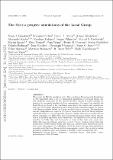The Hestia project: simulations of the Local Group
Author(s)
Libeskind, Noam I; Carlesi, Edoardo; Grand, Robert JJ; Khalatyan, Arman; Knebe, Alexander; Pakmor, Ruediger; Pilipenko, Sergey; Pawlowski, Marcel S; Sparre, Martin; Tempel, Elmo; Wang, Peng; Courtois, Hélène M; Gottlöber, Stefan; Hoffman, Yehuda; Minchev, Ivan; Pfrommer, Christoph; Sorce, Jenny G; Springel, Volker; Steinmetz, Matthias; Tully, R Brent; Vogelsberger, Mark; Yepes, Gustavo; ... Show more Show less
DownloadSubmitted version (11.62Mb)
Open Access Policy
Open Access Policy
Creative Commons Attribution-Noncommercial-Share Alike
Terms of use
Metadata
Show full item recordAbstract
© 2020 The Author(s) Published by Oxford University Press on behalf of the Royal Astronomical Society. We present the hestia simulation suite: High-resolutions Environmental Simulations of The Immediate Area, a set of cosmological simulations of the Local Group. Initial conditions constrained by the observed peculiar velocity of nearby galaxies are employed to accurately simulate the local cosmography. Halo pairs that resemble the Local Group are found in low resolutions constrained, dark matter only simulations, and selected for higher resolution magneto hydrodynamic simulation using the arepo code. Baryonic physics follows the auriga model of galaxy formation. The simulations contain a high-resolution region of 3-5 Mpc in radius from the Local Group mid-point embedded in the correct cosmographic landscape. Within this region, a simulated Local Group consisting of a Milky Way and Andromeda like galaxy forms, whose description is in excellent agreement with observations. The simulated Local Group galaxies resemble the Milky Way and Andromeda in terms of their halo mass, mass ratio, stellar disc mass, morphology separation, relative velocity, rotation curves, bulge-disc morphology, satellite galaxy stellar mass function, satellite radial distribution, and in some cases, the presence of a Magellanic cloud like object. Because these simulations properly model the Local Group in their cosmographic context, they provide a testing ground for questions where environment is thought to play an important role.
Date issued
2020Department
Massachusetts Institute of Technology. Department of PhysicsJournal
Monthly Notices of the Royal Astronomical Society
Publisher
Oxford University Press (OUP)
Citation
Libeskind, Noam I, Carlesi, Edoardo, Grand, Robert JJ, Khalatyan, Arman, Knebe, Alexander et al. 2020. "The Hestia project: simulations of the Local Group." Monthly Notices of the Royal Astronomical Society, 498 (2).
Version: Original manuscript